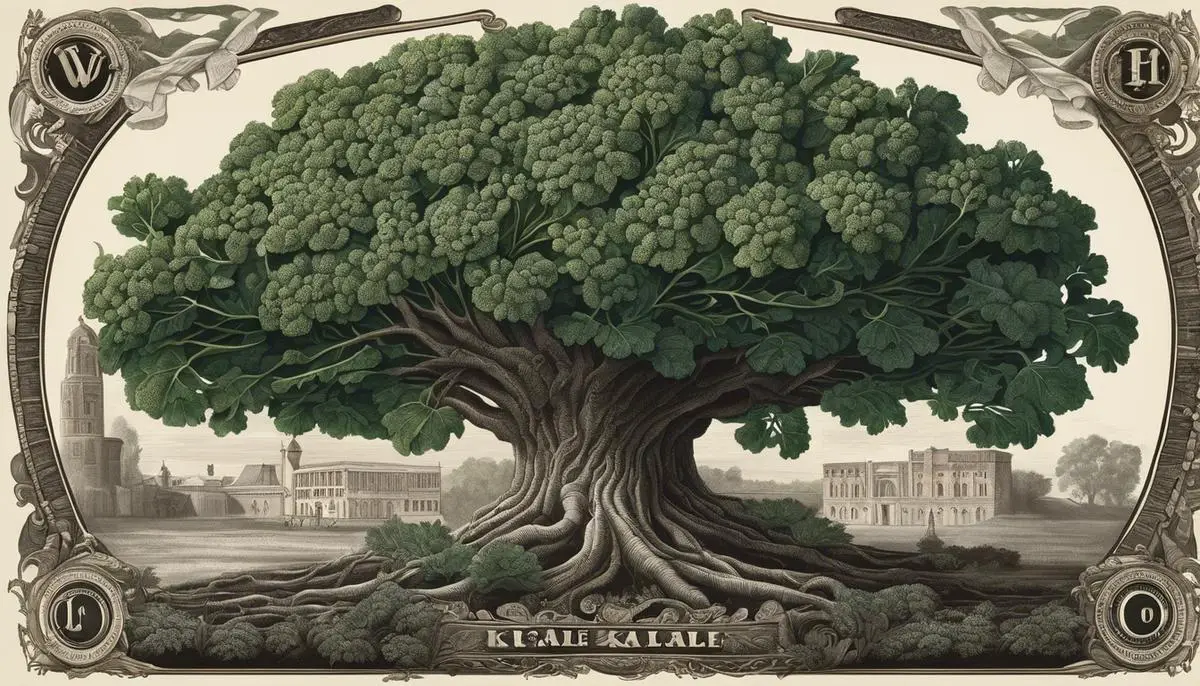Hailed as a superfood and treasured for its robustness, kale has captured the attention of health enthusiasts and chefs alike. Originating from its wild ancestors, kale has undergone an exceptional journey of domestication, leading to a wide array of varieties that thrive in diverse climates and soils. This verdant vegetable does not merely stand out in gardens and plates for its aesthetic appeal; kale’s cultivation and history are deeply rooted in the tapestry of human agricultural innovation. By exploring the wondrous world of kale, we unearth a lineage that talks of resilience and adaptation, a nutritional goldmine that fortifies our bodies against the ailments of modernity, and a genetic marvel that illustrates the power of selective breeding in shaping the food of tomorrow.
Cultivation and History of Kale
The cultivation and diversity of kale varieties, Brassica oleracea var. sabellica, encapsulate a rich tapestry of agricultural history and genetic variation, meriting rigorous exploration.
Reader Poll: What online courses would interest you?
Kale, a descendent of the wild cabbage, is believed to have originated in the eastern Mediterranean and Asia Minor, where it has been cultivated for food for over 2,000 years. Its durability in cooler climates made it a staple in the diets of medieval Europe, and its cultivation spread extensively, leading to an array of phenotypic diversity reflective of local agrarian conditions.
Subsequent selective breeding practices have amplified this diversity, giving rise to a myriad of kale cultivars distinguished by differences in color, texture, and flavor. Varieties include the tightly curled leaves of Scotch kale, the broad and flat leaves of Russian kale, and the ornamental fringed leaves of redbor kale. These varieties exhibit a spectrum of colors from deep greens to purples and even pinks, showcasing the extensive pigment variations that can be selectively encouraged through horticultural techniques.
Cultivation practices of kale demand consideration of environmental parameters to optimize growth and nutrient content. Kale prefers well-drained fertile soils with organic matter, thrives in cool climates, and requires full sunlight to partial shade. A cruciferous vegetable, kale benefits from crop rotation to prevent soil-borne diseases and is frequently employed as a cover crop to enrich soil with organic nutrients. Harvesting methods vary by variety; leaves may be picked individually from the outer layers, allowing for continued growth, or the entire plant may be harvested at once when mature. These agronomic practices not only sustain the cultivation of this nutrient-rich plant but also contribute to its continuous evolution and selection, underlining the dynamic nature of crop domestication and agricultural biodiversity.
Subscribe to our newsletter!
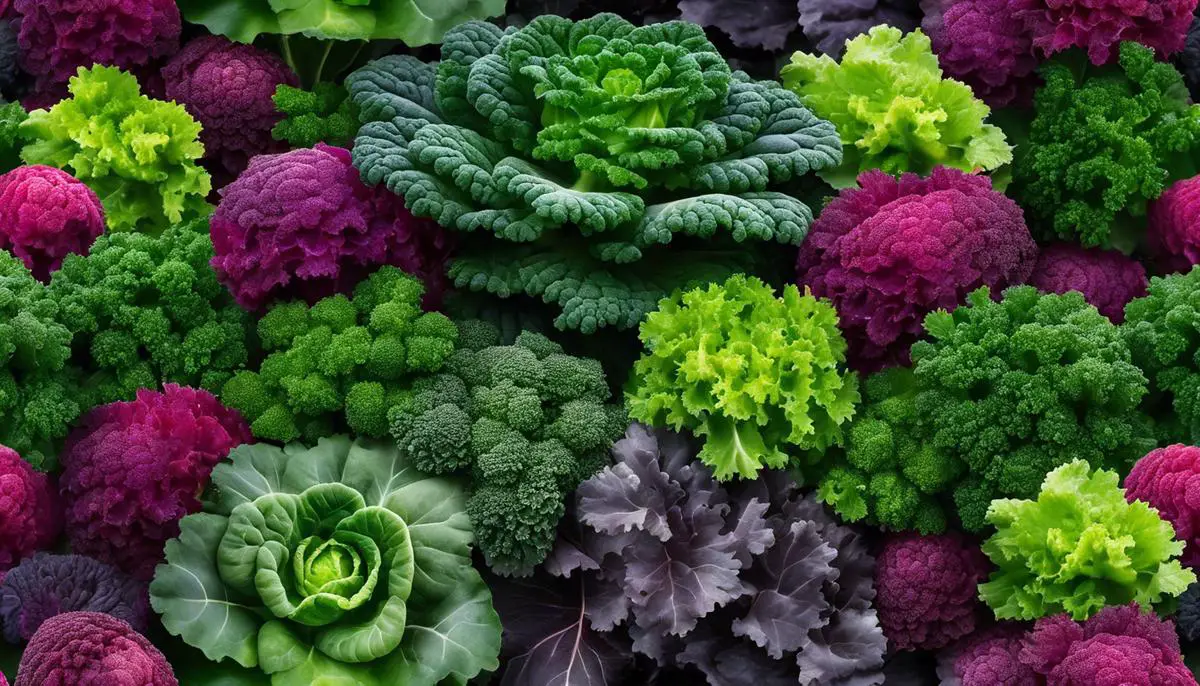
Nutritional Profile and Health Benefits
Kale, a leafy green cruciferous vegetable, is renowned for its high nutritional density, possessing a remarkable array of vitamins, minerals, and antioxidants. Variations in kale types, such as lacinato, curly, and ornamental kale, yield subtle differences in nutrient composition, contributing to their health-promoting properties.
The dark, robust leaves of most kale varieties are rich in vitamins A, C, K, and various B vitamins, including folate, essential for cellular function and tissue growth. Minerals like calcium, potassium, and magnesium contribute to bone health, proper muscle function, and regulation of blood pressure.
Moreover, the health benefits of kale are tremendously enhanced by its concentration of bioactive compounds, such as glucosinolates, which during consumption, transform into isothiocyanates, known for their cancer-protective properties. The wealth of antioxidants, including quercetin and kaempferol, play a vital role in reducing oxidative stress and inflammation, implicated in a myriad of chronic diseases.
The high dietary fiber content in kale also supports digestive health and has been associated with a lower risk of heart disease. The interplay of these nutrients varies among different kale types, lending a specific health-promoting profile to each variety.
Given its nutrient makeup, kale stands out as a superfood in the realm of leafy greens. Consuming a mixture of kale types could potentially offer a broader spectrum of benefits, engaging the synergistic effects of their diverse phytochemicals and nutrients. Understanding the specific nutritional advantages of each kale type allows consumers and health practitioners to tailor dietary choices that align with individual health goals and nutritional needs.
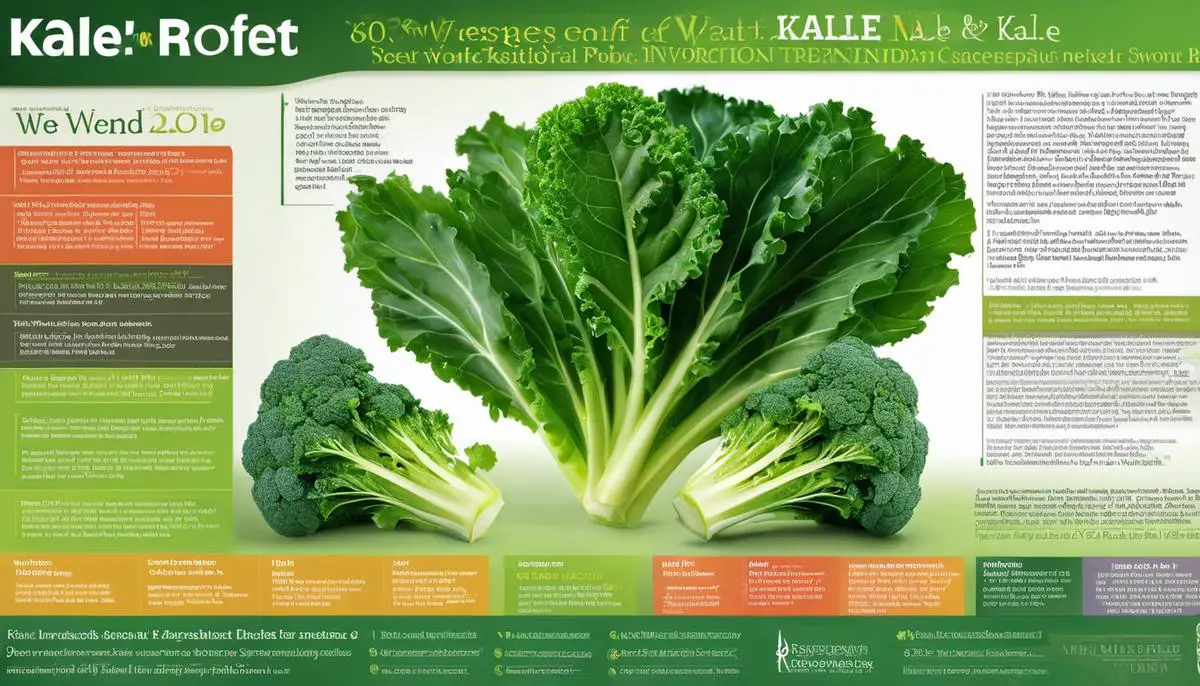
Genetic Diversity and Botanical Classification
Molecular markers present an advancement in botanical classification, and their utilization in distinguishing between kale (Brassica oleracea var. sabellica) varieties has paved the way for a nuanced understanding of genetic relationships. The amplification of microsatellite DNA sequences, which are distributed throughout the plant genome, has provided insights into the genetic structure underlying the morphological variations observed between kale populations. This technique enables scientists to trace genetic lineage and pinpoint markers associated with beneficial traits such as disease resistance and nutrient composition.
The genetic diversity among the kale varieties bears significant implications for both conservation and plant breeding strategies. It is essential to maintain a broad genetic base to ensure resilience against pests, diseases, and changing climatic conditions. Botanical classification is not merely an academic exercise, as it has direct applications in the field of agriculture. Understanding the precise genetic makeup of kale varieties assists plant breeders in developing new cultivars that harness desired traits. For instance, incorporating genes conferring high concentrations of glucosinolates—which have shown promise in combatting certain types of cancer—into popular kale varieties could enhance their health-giving properties.
In the realm of nutrition science, profiling the diversity of core components across the kale spectrum remains a key research endeavor. This encompasses not just the macronutrient framework but also the intricate symphony of micronutrients, enzymes, and phytochemicals that contribute to the nutritional prowess of this leafy green. The sheer diversity in the makeup of anthocyanins, carotenoids, and glucosinolates among kale varieties offers a cornucopia of potential health benefits yet to be fully explored. The concept of “food as medicine” finds a strong advocate in the study of kale’s phytonutrient composition and its variation with genetic diversity. With a keen understanding of these principles, cultivators can orchestrate a kale repertoire that champions both the gustatory and therapeutic aspects of this plant, ensuring that these wholesome greens continue to serve as a cornerstone of nutritious diets worldwide.
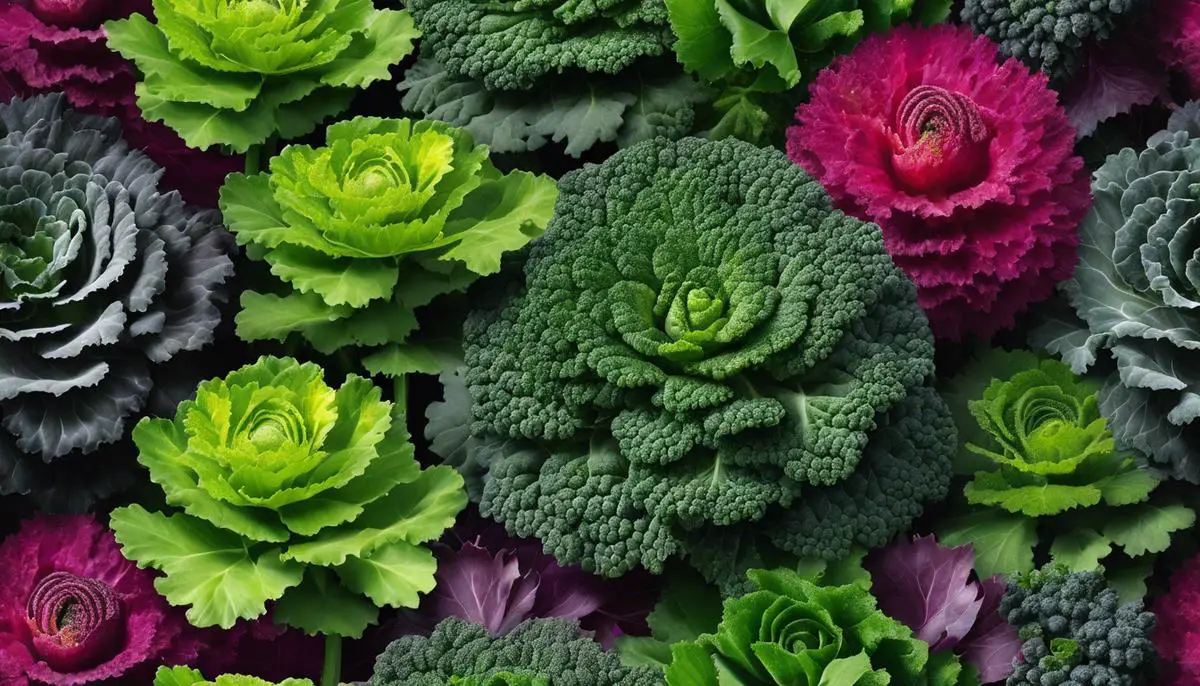
Culinary Uses and Varietal Differences
When considering kale varieties as components in culinary applications, one must account for the textural attributes of each to ensure appropriateness for the dish at hand.
Certain cultivars like Curly kale, characterized by its ruffled leaves and fibrous stem, stand up robustly in cooked applications, such as sautéing or braising. The curly variety retains a pleasant, somewhat earthy bitterness after cooking, which pairs well with rich ingredients like pork or with acidic dressings to balance flavors in warm salads.
In contrast, Lacinato kale, also known as dinosaur or Tuscan kale, possesses a smoother texture and slightly sweeter taste, which can be advantageous in raw preparations like salads or pestos. Its tender, yet sturdy leaves can be effectively massaged to break down the fibers, yielding a more palatable structure for raw consumption and allowing for better integration of vinaigrettes or lemon juice.
With culinary trends leaning towards both health-conscious and aesthetically pleasing presentations, Red Russian kale’s blue-green leaves with purple veins provide not only a striking visual but also a delicate texture and a sweeter, almost nutty flavor profile. It is highly suitable for fresh salads, garnishing, or gentle wilting under a light steam. The red and purple pigmentation indicates the presence of anthocyanins, appealing not just to the palate but also contributing to the antioxidant potential of the dish.
Additionally, Baby kale, a variety harvested at an early stage of growth, offers a milder flavor and a more tender consistency, perfect for use in dishes where a less pronounced kale character is desired, such as in smoothies, sandwiches, or as a subtle addition to omelets.
Understanding the unique qualities of kale varieties can significantly enhance the culinary experience, and it is essential to match not only the taste but also the textural attributes of the kale to its intended application. By doing so, one may elevate the gastronomic experience while harnessing the healthful aspects inherent to this versatile leafy green. With a rich tapestry of varieties at one’s disposal, the possibilities of kale’s applications in the culinary arts remain as vast as ever, inviting chefs and food aficionados alike to explore its bounty in alignment with their creative aspirations and nutritional needs.
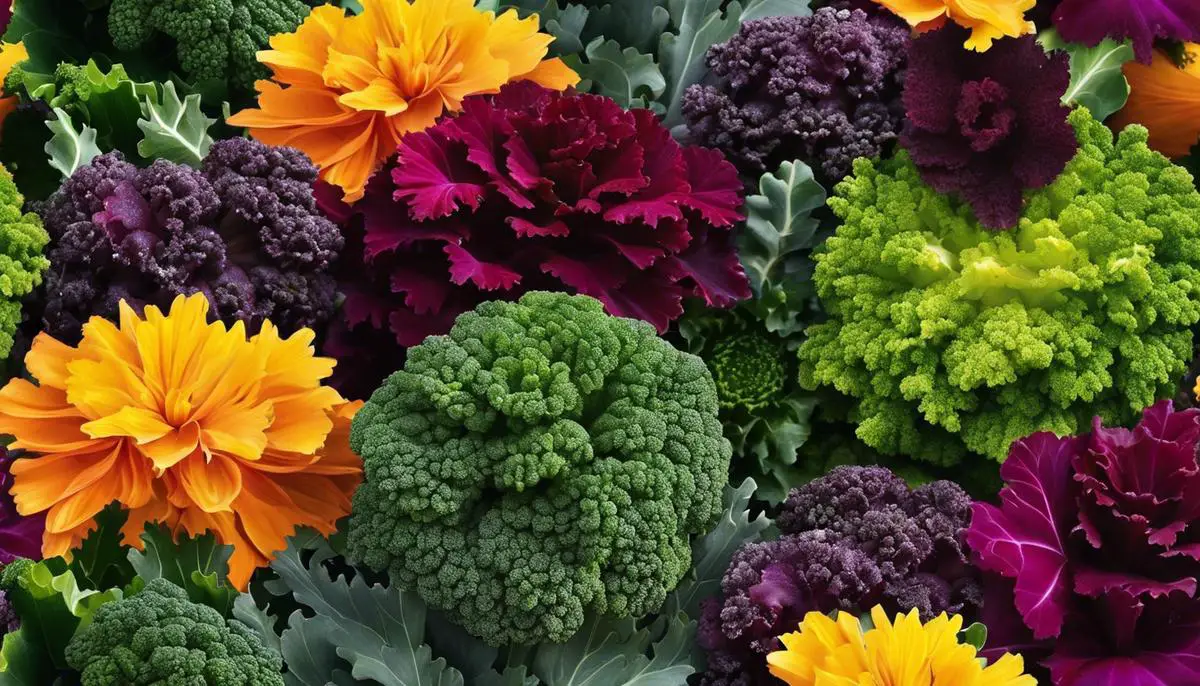
From its humble beginnings on the peripheries of ancient fields to its contemporary status as a culinary darling, kale’s odyssey is emblematic of nature’s splendor and human ingenuity. The remarkable palette of flavors and textures that kale brings to the table is a testament to its culinary versatility. Each leaf narrates a story of centuries-old farming traditions, innovative breeding, and a passionate quest to enhance our culinary experiences and well-being. By embracing the diverse contributions of kale—from the soil to the supper—our appreciation deepens for this leafy green, which has been so artfully woven into the fabric of human nutrition and culture.

